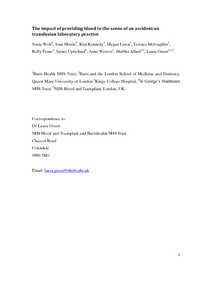Wolf, S; Morris, J; Kennedy, K; Lawn, M; Mcloughlin, T; Feane, K; Uprichard, J; Weaver, A; Allard, S; Green, L
(2018)
The impact of providing blood to the scene of an accident on transfusion laboratory practice.
Transfus Med, 28 (1).
pp. 56-59.
ISSN 1365-3148
https://doi.org/10.1111/tme.12397
SGUL Authors: Uprichard, James
![[img]](https://openaccess.sgul.ac.uk/109471/1.hassmallThumbnailVersion/The%20impact%20of%20providing%20blood%20to%20the%20scene%20of%20an%20accident%20on%20transfusion%20laboratory%20practice.pdf)  Preview |
|
PDF
Accepted Version
Available under License ["licenses_description_publisher" not defined].
Download (550kB)
| Preview
|
Abstract
BACKGROUND: Haemorrhage is the leading cause of mortality during trauma. In 2012, London's Air Ambulance introduced Blood on Board (BOB), transfusing group O red cells (RBC) to trauma patients at the scene. OBJECTIVES: This study assessed the impact of BOB on the number of mixed field samples received by the laboratory, the number of group O RBC transfused to non-group O patients and the ratio of RBC to fresh frozen plasma (FFP) transfused in the initial 24 h. METHODS: Three major trauma centres collected data on patients for whom the major haemorrhage protocol was activated between August 2008 and February 2012 pre-BOB and March 2012 and December 2013 post-BOB. RESULTS: A total of 233 trauma patients were identified pre-BOB and 119 post-BOB. There was no significant difference in the percentage of group O units transfused to non-group O patients (75 vs 82%, P = 0·21) or the RBC : FFP ratio (pre-BOB mean 1·6 [interquartile range (IQR) 1·0-2·0]; post-BOB mean 1·7 [IQR 1·1-2·2], P = 0·24). There was no significant difference in the percentage of mixed field samples received (23% vs 27%, P = 0·3). CONCLUSION: The introduction of BOB did not change the proportion of group O RBC transfused or the RBC : FFP ratio; however, the proportion of acceptable samples decreased. This is largely due to an increase in blood samples not received from the post-BOB cohort, which we believe is probably due to patients who died at the scene. We have introduced robust systems to indicate reasons for not obtaining samples.
| Item Type: |
Article
|
| Additional Information: |
This is the peer reviewed version of the following article: Wolf, S. , Morris, J. , Kennedy, K. , Lawn, M. , Mcloughlin, T. , Feane, K. , Uprichard, J. , Weaver, A. , Allard, S. and Green, L. (2018), The impact of providing blood to the scene of an accident on transfusion laboratory practice. Transfusion Med, 28: 56-59, which has been published in final form at https://doi.org/10.1111/tme.12397. This article may be used for non-commercial purposes in accordance with Wiley Terms and Conditions for Use of Self-Archived Versions. |
| Keywords: |
haemorrhage, laboratory practice, pre-hospital, resuscitation, trauma, haemorrhage, laboratory practice, pre-hospital, resuscitation, trauma, Cardiovascular System & Hematology, 1103 Clinical Sciences |
| SGUL Research Institute / Research Centre: |
Academic Structure > Infection and Immunity Research Institute (INII) |
| Journal or Publication Title: |
Transfus Med |
| ISSN: |
1365-3148 |
| Language: |
eng |
| Dates: |
| Date | Event |
|---|
| 12 February 2018 | Published | | 12 March 2017 | Published Online | | 5 February 2017 | Accepted |
|
| Publisher License: |
Publisher's own licence |
| PubMed ID: |
28295747 |
 |
Go to PubMed abstract |
| URI: |
https://openaccess.sgul.ac.uk/id/eprint/109471 |
| Publisher's version: |
https://doi.org/10.1111/tme.12397 |
Statistics
Item downloaded times since 05 Jan 2018.
Actions (login required)
 |
Edit Item |



